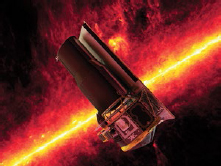2003
Spitzer Space Telescope
Galaxies, stars, planets, moons, asteroids, comets, and even cosmic dust grains all emit thermal infrared energy that is dependent on temperature, composition, and environment. During recent decades astronomers have used sensitive new infrared detectors to study the thermal energy from these objects. Major advances came in 1983 with the launch of the Infrared Astronomical Satellite (IRAS), which conducted the first all-sky survey of infrared heat energy emitted by cosmic objects, and then in 1995 with the launch of the Infrared Space Observatory (ISO) satellite, which followed up IRAS discoveries with higher-resolution imaging and spectroscopy observations until early 1998. IRAS and ISO made important discoveries about circumstellar disks and planet formation processes, as well as star formation and galaxy evolution.
Motivated by these discoveries, NASA dedicated its fourth and final Great Observatory satellite to an IRAS/ISO follow-up mission initially called the Space Infrared Telescope Facility, and later renamed the Spitzer Space Telescope after the American astronomer and long-time space telescope advocate Lyman Spitzer. Spitzer was launched in 2003 and was “parked” in a heliocentric orbit close enough to Earth to allow frequent, high-bandwidth communications but far enough away to avoid interference from Earth’s thermal background signature.

Spitzer used liquid helium to cool its instruments below 4 kelvins, making them supersensitive to extremely faint cosmic sources of thermal energy. Astronomers exploited the ability to see through optically thick dust in the infrared field to study star-forming regions such as the Orion Nebula. Major discoveries were also made studying quasars, galaxies, protoplanetary disks, hot young stars, extrasolar planets, and our own solar system. The telescope’s supply of helium ran out in 2009, but Spitzer continues to make less sensitive but still unique measurements of many infrared sources, and is expected to operate for many more years.
SEE ALSO Star Color = Star Temperature (1893), Circumstellar Disks (1984), Hubble Space Telescope (1990), Planets Around Other Suns (1995), Chandra X-ray Observatory (1999).
A false-color infrared composite photo, taken by the NASA Spitzer Space Telescope (seen in an artist’s conception, left, of a star formation in the heart of the Orion Nebula (a region known as the Trapezium), merged with a 2-micron all-sky survey background photo of the stellar neighborhood.
